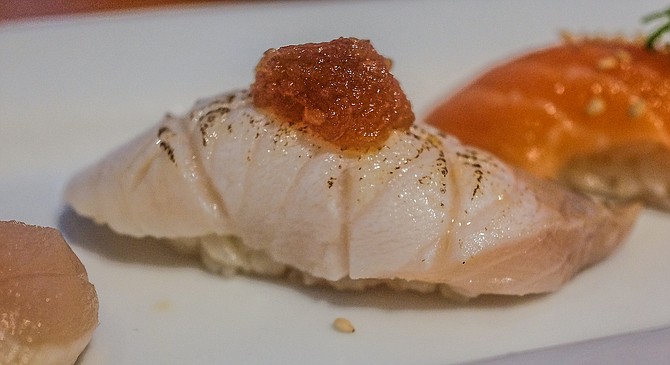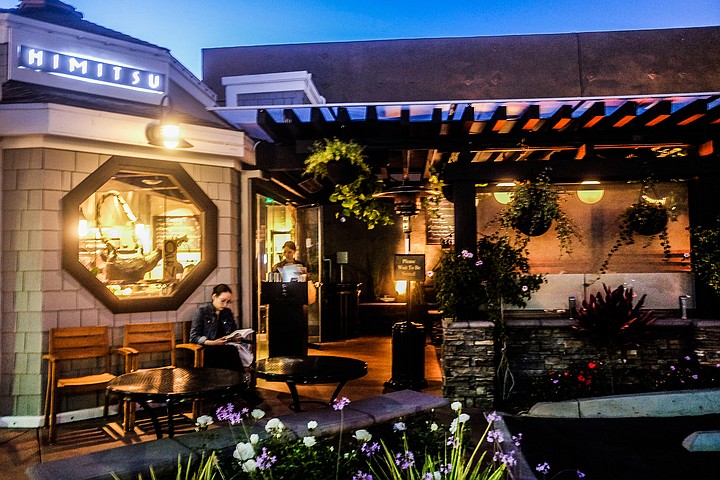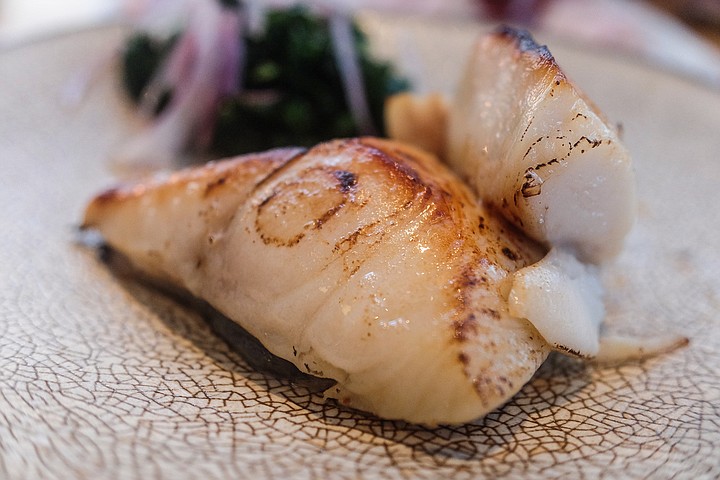 Facebook
Facebook
 X
X
 Instagram
Instagram
 TikTok
TikTok
 Youtube
Youtube

“Would love awesome anything but esp sushi,” read the text. L.A. friends had come to see Carlsbad’s Flower Fields and wanted to meet for dinner in La Jolla.
I can rattle off a list of awesome restaurants in La Jolla, but their request forced me to realize: a dedicated sushi spot wasn’t among them. Except there’s this new one we could try, credited to a protégé of San Diego’s favorite sushi chef, Yukito Ota.

Himitsu, it’s called. Google tells me that translates to “secret,” but it’s also a play on the name of chef Mitsu Aihara, who indeed learned from the best over 16 years at Sushi Ota. Originally from a town outside of Tokyo, Aihara never learned sushi in Japan, and he didn’t move to San Diego to learn it either. He came for the same reason as many 18-year-olds. To surf.

He told us this as we neared the end of our meal. We weren’t seated at his sushi bar, rather at the back of an enclosed dining patio, at the opposite end of the restaurant. Nevertheless, Chef Mitsu stopped at ours and fellow tables, ensuring everyone was having fun. Yes we were. And as I will for the next couple paragraphs, I took the opportunity to gush my appreciation.
Let’s start with the nigiri menu, where sushi standbys such as hamachi (yellowtail) and sake (salmon) go $3 apiece. However, the more prized and tender cuts, hamachi belly and sake belly, go for $3.50. I don’t know that a 50-cent upgrade has ever tasted so good as those long, delicate morsels of fish.
Uni cost $7.50 per piece, but that melt-on-contact sea urchin tasted better than La Jolla Cove looks. We eyed the bluefin tuna ($4), and its fattier belly cut, chu toro ($5.50), but bypassed both for the fattier still o toro ($7.50). Was the upgrade worth it? I suppose it’s subjective, but good luck finding a better mouthful of fish at any price.
It’s not all sushi at Himitsu, and we split a grilled hamachi collar so succulent and clean, I barely touched the side of sauce meant to dress the moist fish. But I couldn’t take my eyes off the miso black cod. I’ve never tried Nobu’s famous take on this dish, but if it’s remotely like this, I understand every bit of that chef’s global success. Mildly sweet with almost no discernable salt, it relies on the beautiful umami of a much better quality miso than I’m accustomed to, and flesh so butterlike, flakes of it slid right off the filet onto my plate.
I’ve noticed an increase of black cod on local menus of late, and this is why. It’s not cod like you’d get at a fish’n’chips joint, but like you’d find smoked in a Jewish deli, under its other name: sablefish. As I momentarily learned, the Japanese name for it is gindara (with a hard G), and it was listed on the sushi specials menu this night ($5).
I tried it, and let’s just say I’m out of words to fawn any longer. There aren’t many seats at this valuable little sushi addition to La Jolla, so reserve one soon. It won’t remain a himitsu much longer.


“Would love awesome anything but esp sushi,” read the text. L.A. friends had come to see Carlsbad’s Flower Fields and wanted to meet for dinner in La Jolla.
I can rattle off a list of awesome restaurants in La Jolla, but their request forced me to realize: a dedicated sushi spot wasn’t among them. Except there’s this new one we could try, credited to a protégé of San Diego’s favorite sushi chef, Yukito Ota.

Himitsu, it’s called. Google tells me that translates to “secret,” but it’s also a play on the name of chef Mitsu Aihara, who indeed learned from the best over 16 years at Sushi Ota. Originally from a town outside of Tokyo, Aihara never learned sushi in Japan, and he didn’t move to San Diego to learn it either. He came for the same reason as many 18-year-olds. To surf.

He told us this as we neared the end of our meal. We weren’t seated at his sushi bar, rather at the back of an enclosed dining patio, at the opposite end of the restaurant. Nevertheless, Chef Mitsu stopped at ours and fellow tables, ensuring everyone was having fun. Yes we were. And as I will for the next couple paragraphs, I took the opportunity to gush my appreciation.
Let’s start with the nigiri menu, where sushi standbys such as hamachi (yellowtail) and sake (salmon) go $3 apiece. However, the more prized and tender cuts, hamachi belly and sake belly, go for $3.50. I don’t know that a 50-cent upgrade has ever tasted so good as those long, delicate morsels of fish.
Uni cost $7.50 per piece, but that melt-on-contact sea urchin tasted better than La Jolla Cove looks. We eyed the bluefin tuna ($4), and its fattier belly cut, chu toro ($5.50), but bypassed both for the fattier still o toro ($7.50). Was the upgrade worth it? I suppose it’s subjective, but good luck finding a better mouthful of fish at any price.
It’s not all sushi at Himitsu, and we split a grilled hamachi collar so succulent and clean, I barely touched the side of sauce meant to dress the moist fish. But I couldn’t take my eyes off the miso black cod. I’ve never tried Nobu’s famous take on this dish, but if it’s remotely like this, I understand every bit of that chef’s global success. Mildly sweet with almost no discernable salt, it relies on the beautiful umami of a much better quality miso than I’m accustomed to, and flesh so butterlike, flakes of it slid right off the filet onto my plate.
I’ve noticed an increase of black cod on local menus of late, and this is why. It’s not cod like you’d get at a fish’n’chips joint, but like you’d find smoked in a Jewish deli, under its other name: sablefish. As I momentarily learned, the Japanese name for it is gindara (with a hard G), and it was listed on the sushi specials menu this night ($5).
I tried it, and let’s just say I’m out of words to fawn any longer. There aren’t many seats at this valuable little sushi addition to La Jolla, so reserve one soon. It won’t remain a himitsu much longer.
Comments